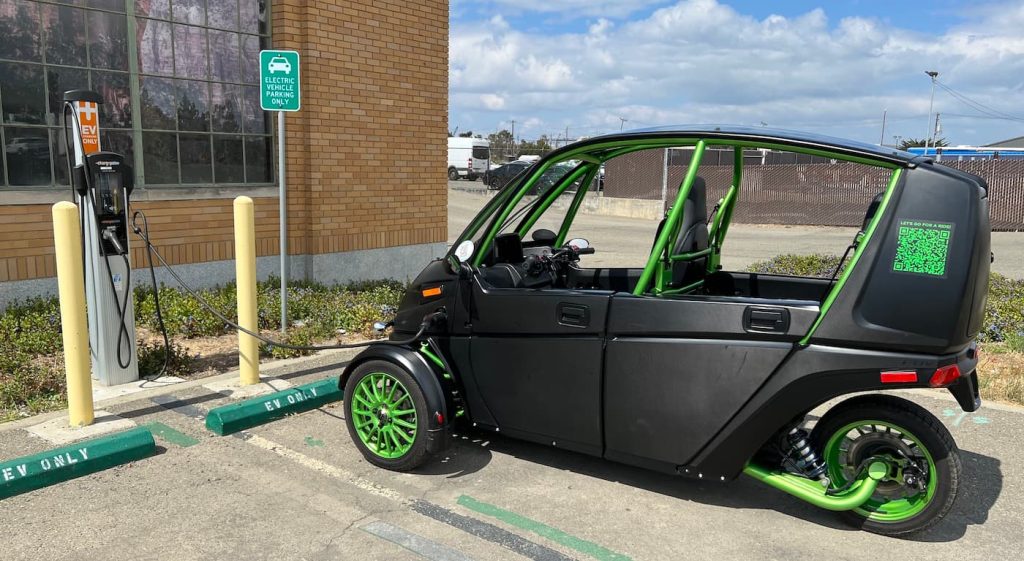
Arcimoto was once the darling of the electric vehicle startup world, riding a green wave of EV investments to a $1 billion valuation in 2021. But the Eugene, Oregon-based electric automaker has since experienced a slow and arduous fall from grace. After multiple bumps in the road, a potential sinkhole may have opened in front of the company in the form of looming bankruptcy.
Arcimoto’s three-wheeled electric vehicles, dubbed the Fun Utility Vehicle or FUV, were once touted as cost-effective alternatives to pricier luxury electric cars.
The $20,000 three-wheelers weren’t actually full-fledged cars, at least not according to the local DMV. Despite reaching highway speeds, the trike design put them in the motorcycle (and sometimes autocycle) category with reduced regulatory hurdles. That helped keep prices down compared to “real” electric cars, but it never seemed to manifest into the kind of demand that Arcimoto had hoped for.
The company had hoped that reaching mass production would help it drop the price to $12,000, but despite lofty promises, that mass production never materialized.

Arcimoto moved into a larger production facility last year but has now been forced to pause production entirely due to insufficient funds. Arcimoto fell short of its production goals last year, and in the last six months produced just 252 vehicles. Only 115 vehicles were delivered to customers, according to The Oregonian.
Despite laying off and furloughing over 100 employees last year, the company’s expensive US-based production could no longer be sustained.
In a last-ditch effort to raise funding, yesterday Arcimoto announced the sale of $12 million in stock at just $3 per share, or less than half of the stock price at the time. That caused the publicly traded company’s stock price to plummet. Despite closing at $6.21 per share on Tuesday, Arcimoto’s price on the NASDAQ had dropped to just $2.48 at market close the next day.
The company explained in a regulatory filing accompanying the raise that without funding, the company’s future was at stake. Arcimoto explained that it had “halted our production of vehicles and will require substantial additional funding to resume production.” The company continued by stating that if additional funding was not raised, “we will be required to cease our operations and/or seek bankruptcy protection.”

The devastating news comes at a time when Arcimoto had been in development of a new three-wheeled micro-mobility vehicle designed to improve up on the stability of more conventional electric bicycles. Many had hoped that this new three-wheeled leaning e-bike could have have found much more mass-market appeal than the larger FUV.
We’ve reached out to representatives for Arcimoto for comment, but have not heard back by the time of publishing.
Electrek’s Take
The news of Arcimoto’s precarious financial standing is unfortunate, but not altogether surprising considering the FUV’s inability to find the demand it required for mass production.
It’s not that the vehicle wasn’t impressive. I’ve taken test spins in FUVs multiple times and have always enjoyed the experience in what felt like a high-power street-legal go-kart. Electrek’s Jameson Dow also wore a big grin after his own test drive experience (see below).

The problem is that the FUV never seemed to break out of that “funmobile” niche, despite Arcimoto’s extensive efforts to roll out utility, delivery, and first responder versions of the vehicle.
Average commuters didn’t seem to embrace the idea that such a fun, open-air vehicle could be a true car replacer. Most owners used their Arcimotos as second and third vehicles, taking the FUV out for joyrides or using it for specific tasks that fit a two-seater open-air vehicle.
As something of a compromise between a car and a motorcycle, the FUV still suffered from the downsides of both as well, being too wide to lane split during traffic jams but too small and exposed to provide the extra safety and protection benefits of a car. And while I personally have always had a blast driving Arcimoto vehicles, the company just doesn’t seem to have been able to translate the joy of driving into a thick order book and deliveries.
I’d love to see Arcimoto find the right funding or a buyer in the 11th hour to turn things around and save the company. But if that doesn’t happen and things go south, I’ve got no doubt in my mind that the FUVs already on the road will eventually become collector’s items. They’re just too cool and too rare not to. Think of Tuckers, DeLoreans, and other cars from out-of-the-box and forward-thinking car makers that just couldn’t find the financing to sustain production for more than a few years. So if you’ve got one now, you might want to hold onto it.
FTC: We use income earning auto affiliate links. More.











